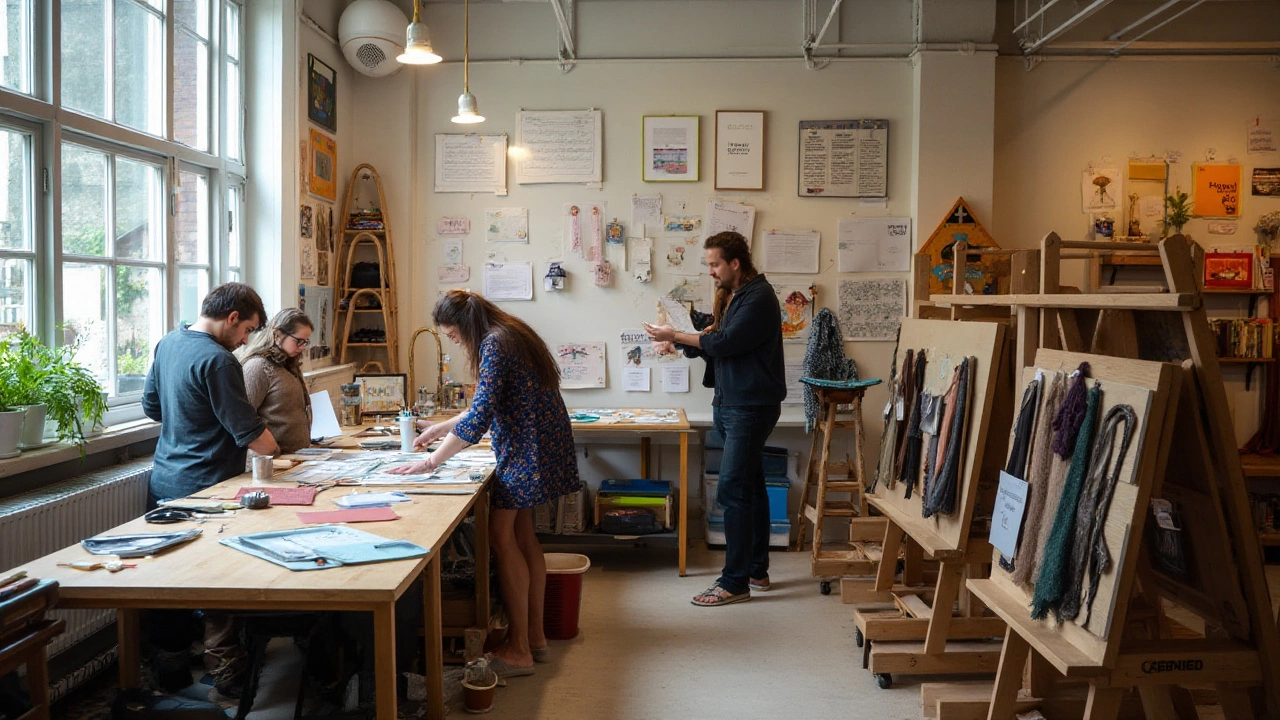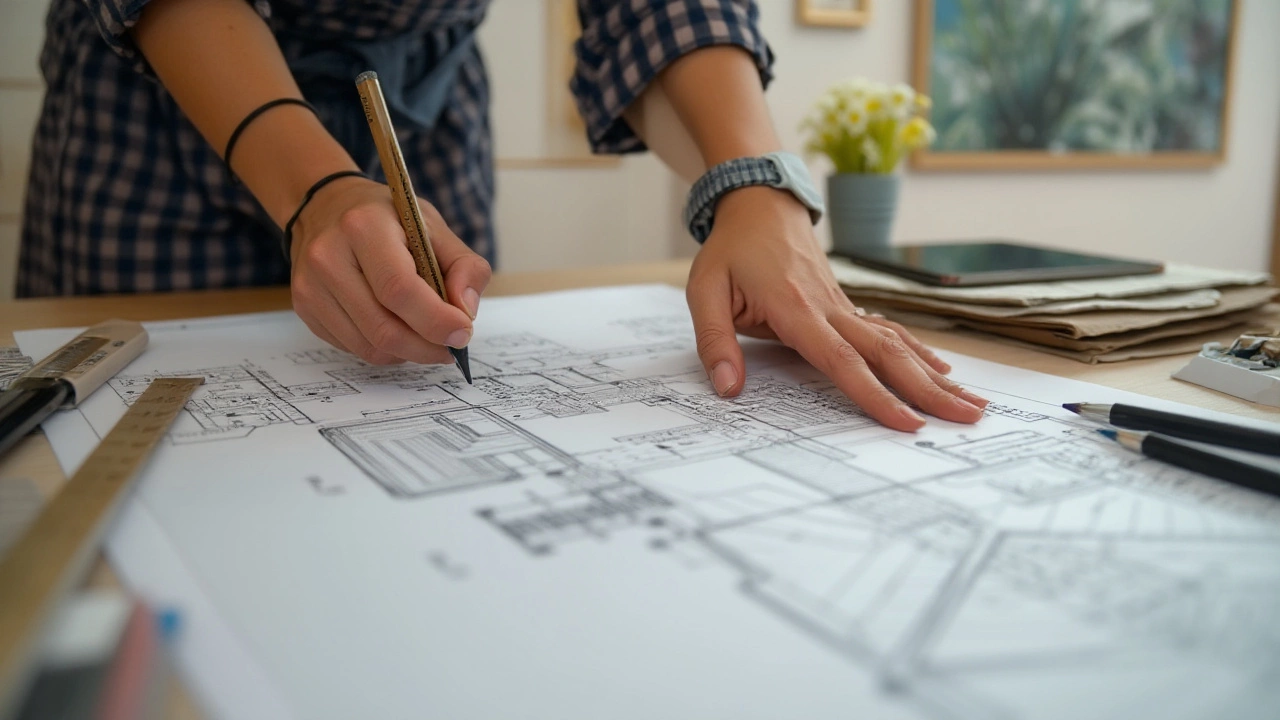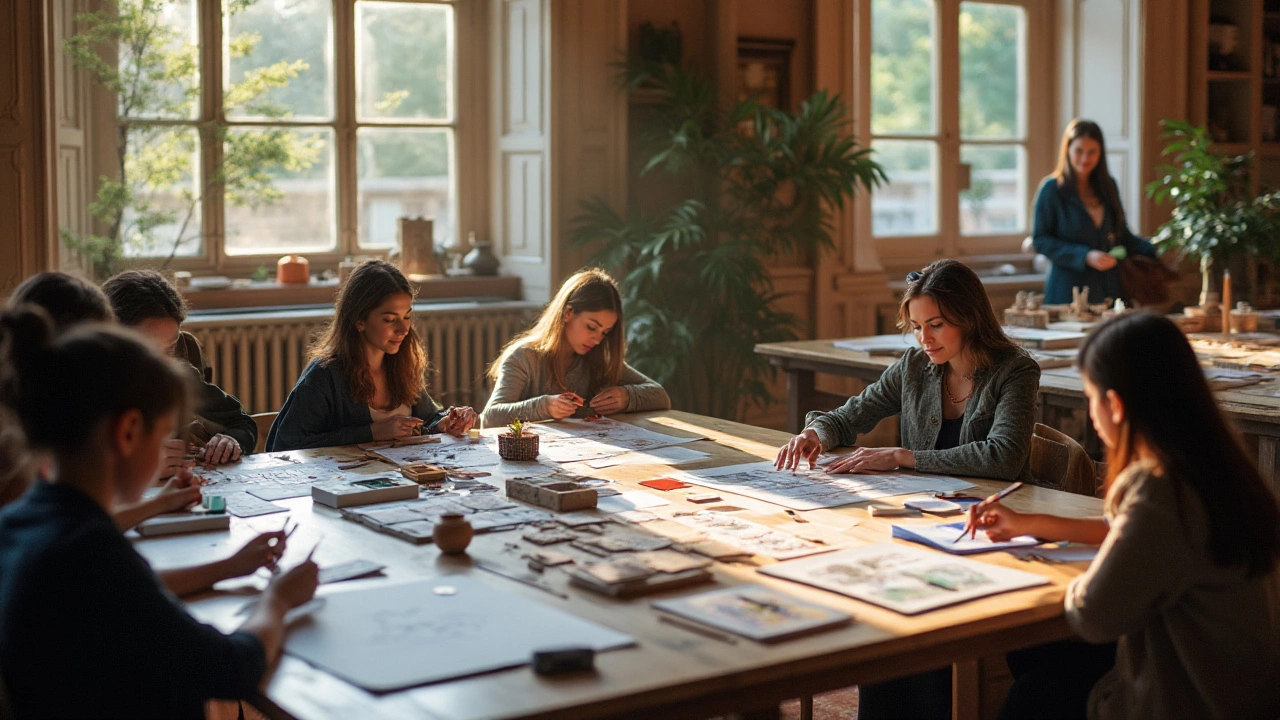Interior design is a fascinating field that marries creativity with precision to transform spaces into both practical and beautiful environments. It requires a unique blend of skills, including an eye for aesthetics, an understanding of spatial layout, and the ability to work with diverse materials and styles.
The journey into this profession often starts with formal education. Many aspiring designers pursue certificates, diplomas, or degrees in interior design to learn the theoretical and practical aspects of the craft. These programs cover various topics such as design principles, history of design, color theory, and technical drawing.
- Understanding Interior Design as a Discipline
- Educational Requirements and Pathways
- Gaining Practical Experience
- Key Skills for Interior Designers
- Traits of Successful Interior Designers
Understanding Interior Design as a Discipline
When you think of interior design, visions of elegantly decorated living rooms and chic hotel lobbies might dance in your mind. But interior design is much more than just decorating. As a discipline, it encompasses a broad spectrum of activities aimed at creating environments that are both stunning and utilitarian. Interior designers don't just think about aesthetics—they consider how spaces work and how people interact with them. This comprehensive approach requires creativity infused with a keen understanding of architecture, psychology, and sustainability.
An often-quoted perspective in the design world comes from the acclaimed designer, Jonathan Adler, who once said, "Living beautifully is a way of showing respect to the people around you." This sentiment underscores the idea that interior design impacts more than just the eyes; it enriches lives by enhancing the spaces where life unfolds. The discipline involves planning and designing interior spaces in a way that is not only pleasing but also responds to the fundamental needs of safety, accessibility, and comfort.
Interior design as a discipline also straddles the line between art and science. Designers use art to communicate through color, texture, and form, but their work is grounded in fundamental scientific principles, like ergonomics and acoustics. Science helps dictate how a room will perform under specific lighting conditions or how materials will handle different levels of wear and tear. This is where technology comes into play as well. Designers often use advanced design software to create detailed spatial plans and realistic renderings, bridging the gap between client visions and reality.
Impact of Cultural Influences
The rich tapestry of interior design is also woven with threads of different cultural influences. What is considered a minimalistic design in one part of the world might be seen as sparse or incomplete elsewhere. Designers must, therefore, be cultural chameleons, able to adapt their designs to reflect diverse ethnic influences while maintaining an overarching theme of harmony and balance. This adaptation is crucial, especially when designing public or commercial spaces that must appeal to a wide array of cultural backgrounds.
Let's not forget the role of sustainability. In today's environmentally conscious society, interior designers are expected to incorporate sustainable practices into their designs. This might include selecting materials that are locally sourced, recycled, or otherwise eco-friendly. An awareness of the environmental impact of certain design choices is paramount, and many clients are increasingly asking for eco-conscious decisions.
Educational Requirements and Pathways
Diving into the world of interior design begins with understanding the various educational paths available. While some old-school designers may have crafted their skills through apprenticeships or self-teaching, the modern route often involves formal education. This not only hones your technical expertise but also builds credibility in an increasingly competitive field.
Most aspiring designers opt for a bachelor's degree in interior design, which typically spans three to four years, depending on the country and institution. These programs immerse students in a comprehensive study of architectural principles, computer-aided design (CAD), color theory, and even furniture design. It's a blend of creativity and science, aimed at preparing students for the multifaceted challenges of interior design. Notably, as technology continues to shape the industry, proficiency in software tools such as AutoCAD, SketchUp, and Revit has become indispensable.
For those seeking a quicker entry into the profession, diploma and certificate programs offer condensed curricula that focus on essential skills. These typically last one to two years and may be ideal for those who already possess some design knowledge or experience. They often include internships or work placements, offering real-world exposure that is critical for success.
Advanced Studies and Specializations
Beyond foundational education, there's room for specialization, allowing designers to carve niches in areas like sustainable design, lighting, or bespoke furniture creation. Master’s degrees and post-graduate diplomas provide deep dives into these aspects, enhancing expertise and potentially leading to higher-profile projects. According to the Royal Institute of British Architects, advanced studies can significantly impact one's professional trajectory and earning potential.
A crucial aspect often discussed among educators in the field is the importance of accreditation. In the UK, accrediting bodies like the British Institute of Interior Design (BIID) ensure that educational programs meet industry standards, providing assurance to both students and employers. In the United States, the Council for Interior Design Accreditation (CIDA) serves a similar role. These accreditations are not just badges of prestige; they often influence the involvement in professional networks and community discussions.
"Education is not the filling of a pail, but the lighting of a fire," said W.B. Yeats. In the context of interior design, this quote resonates deeply, as educational pathways are designed to ignite passion and foster innovation.
In choosing an educational path, prospective designers should consider factors like curriculum focus, faculty expertise, and opportunities for hands-on experience. These elements can significantly shape a designer's skills and perspective, ultimately determining their unique contribution to the world of interior design.

Gaining Practical Experience
Acquiring practical experience in interior design is indispensable for anyone looking to thrive in the field. This hands-on training bridges the gap between classroom knowledge and real-world application. By stepping into actual design environments, budding designers get the opportunity to refine their skills, understand client needs, handle budgets, and work within the constraints of a project timeline. Moreover, practical experience often involves working as part of a team, an essential aspect, since collaboration is key in many design projects.
Internships are a primary avenue through which many aspiring designers gain this all-important on-the-job experience. These opportunities are invaluable as they provide a close-up view of how design-projects operate from start to finish, often involving interactions with clients, contractors, and other stakeholders. Interns get to observe and participate in the brainstorming, planning, and execution stages of projects, giving them a well-rounded understanding of the design process. According to the Design Council, "a hands-on internship can sometimes be as educational as years spent in the classroom." Experiences like these are a great way to start building a professional portfolio, also crucial for securing future employment.
To get the most out of practical experience, actively engaging in workshops and design competitions can be beneficial. Many industry bodies and educational institutions host annual contests challenging designers to solve real-world problems creatively. These contests not only hone technical and creative skills but also provide exposure to emerging trends and innovations in interior design. They're a fantastic platform for young designers to showcase their ability and often, winning or performing well can significantly boost one's credentials in the eyes of future employers.
Networking is a pivotal part of gaining practical experience too. As designers interact with professionals and peers, they build relationships that can open doors to new opportunities and collaborations. Attending industry events and conferences can be another excellent way to network. They frequently feature discussions led by influential figures where emerging trends are highlighted, and design philosophies debated. Recognizing the importance of these gatherings can lead to unexpected collaborations or job offers.
An emerging trend in gaining practical experience is through virtual or remote design projects, especially given the recent technological advances and the global shift towards remote working environments. Designers now have the chance to work on international projects without leaving their home country, effectively broadening their experience beyond local design practices. Participating in these virtual projects allows for a deeper understanding of cultural aesthetics and different client preferences. This adaptability and versatility in design approach can be a significant asset in one's career.
With all these avenues for gaining practical experience, one crucial aspect to keep in mind is continually seeking feedback. Constructive criticism plays a vital role in personal growth and improvement. By assessing what worked, what didn’t, and understanding why, designers can evolve their style and approach to align better with client needs and industry standards. Documenting this journey not only facilitates personal growth but also aids in articulating one's design philosophy clearly to prospective clients or employers through well-documented portfolios and case studies.
Key Skills for Interior Designers
Embarking on a career in interior design requires more than just a knack for decorating. It demands a specific set of skills that blends creativity with practicality to meet a client’s needs effectively. At the heart of it, an interior designer must be able to visualize both the big picture and the minute details simultaneously. This includes having a comprehensive understanding of spatial dynamics and the ability to plan and coordinate projects to optimize space utility and aesthetics. Designers must often think creatively yet strategically, combining their artistic sensibility with an intrinsic understanding of how people interact within an environment.
Technical acumen is equally vital in this profession. Proficiency in design software such as AutoCAD or SketchUp is often a must, allowing designers to recreate and modify their visions digitally before bringing them to life in the real world. This skill set helps in drafting precise layouts, creating 3D representations, and ensuring the feasibility of projects. Mastery over these tools can set apart a designer who can put forth their creative ideas clearly and accurately, establishing trust and transparency with their clients and contractors.
Communication cannot be understated in the realm of interior design. Designers must possess stellar communication skills, which means being able to convey complex ideas simply and effectively. This involves not only presenting their vision to the clients but also collaborating with a plethora of contractors, from builders to electricians, to ensure alignment across all parties involved. A well-spoken designer will navigate client constraints and expectations while advocating for their creative input, leading to a final product that satisfies all stakeholders involved.
Project management is another crucial skill, as interior projects often juggle different components simultaneously. Time management, budgeting skills, and the ability to anticipate project risks or delays can be pivotal to delivering successful projects on time. A smart designer will have a keen sense of resource allocation, ensuring that every penny counts and that quality is never compromised in pursuit of the end goal. This can often mean making hard decisions and problem-solving on the fly when unexpected challenges arise.
Moreover, an in-depth understanding of color theory, textiles, and materials can elevate the designer’s work significantly. Knowing how to play with colors to invoke certain moods, choosing the right materials to ensure durability while maintaining aesthetic appeal, and understanding how textures can add depth or harmony to a space, are common in every great designer's arsenal. As the legendary interior designer Dorothy Draper once said,
"It's just as disastrous to have the wrong accessories in your room as it is to wear sport shoes with an evening dress."Every choice, no matter how small, plays a role in the final harmony of a space.
Lastly, keeping abreast of industry trends and sustainability practices is increasingly important in the modern era of interior design. Designers who can integrate eco-friendly practices and materials into their projects not only appeal to environmentally conscious clients but also contribute to sustainable living, a concept that’s growing in demand by leaps and bounds. Familiarity with green building practices and sustainable material sourcing can offer clients unique, forward-thinking solutions that set a designer apart in a competitive market.

Traits of Successful Interior Designers
Stepping into the realm of interior design demands more than just a sharp eye for color or a knack for rearranging furniture. Successful interior designers are those who wield a combination of skills and personal traits that enable them to craft spaces that are not only aesthetically pleasing but also functional and inviting. One of the most critical traits is creativity. This is the heartbeat of interior design. Creatives look beyond mere trends and draw inspiration from a myriad array of sources, be it nature, fashion, or art movements. They have the ability to envision the potential of a blank space and transform it into something extraordinary.
An equally important trait is attention to detail. Interior design is not just about the big picture; it’s about refining a space to the minutest detail, ensuring that every element coexists harmoniously. From the texture of fabrics to the exact shade of paint, attention to detail can make or break a design. Successful designers know how to balance every component, ensuring that nothing is out of place. Another vital trait that intertwines with this is problem-solving skills. Challenges are frequent, and a designer must be adept at thinking outside the box to find solutions. Whether tackling space restrictions or integrating unexpected client requests, a designer’s problem-solving ability often sets them apart.
Communication skills are also integral. Interior designers must convey their ideas clearly to clients, suppliers, and contractors. This involves not only explaining design concepts but also listening to clients’ needs and feedback. According to a statement by the British Institute of Interior Design, "Successful interior designers possess the unique ability to translate client visions into reality, ensuring satisfaction without compromising creativity." The art of negotiation also falls under this umbrella, as designers often find themselves mediating between various parties to bring a project to fruition.
Moreover, business acumen is crucial, especially for those venturing into their own interior design practice. Understanding budgeting, project management, and effective marketing strategies allows designers to manage not just the creative aspect but also the logistical and financial elements of their projects. As creative entrepreneurs, these professionals often juggle multiple roles, making these business skills invaluable. Additionally, an understanding of technology and keeping up with the latest design software can enhance a designer’s capabilities significantly, enabling them to create more precise and innovative designs.
Persistence and resilience are characteristics that cannot be understated. Design projects can be long and demanding, filled with unexpected hiccups and setbacks. The tenacity to push through challenges and learn from failures is what often defines a designer's career over time. Successful interior designers embrace a mindset of growth, continuously seeking to improve and refine their craft.
